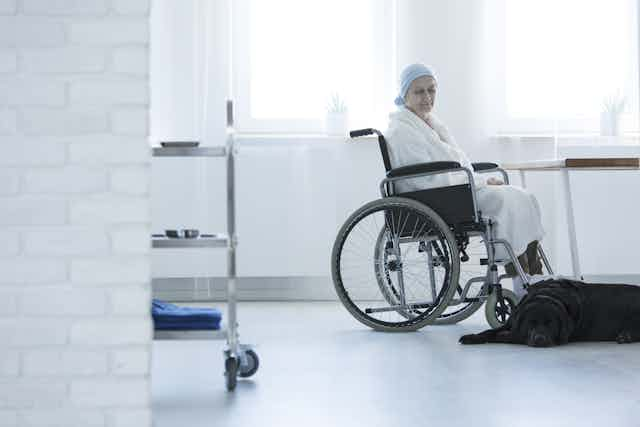Medical assistance in dying (MAID) became a reality in Canada when legislation was passed in July 2016. This is the hastening of death through a lethal dose of medication — either by self-ingestion (assisted suicide) or physician injection (euthanasia).
More than 2,000 Canadians have received MAID, administered by a number of physicians. Few of those doctors are palliative care specialists, who are purposely keeping their distance from MAID to avoid further stigmatization as the physicians of death. They do not want to be associated with treatment failure, or viewed as only providing care to those who have either given up or been deemed hopeless.
This has left MAID without leadership or co-ordination, leading to unequal access and confusion among the public and health-care providers.
I am a palliative care physician at Queen’s University who teaches medical students, residents and other health-care providers. I am adjusting to the new reality of palliative care in the MAID era. Many patients and families ask me about it and a fair number receive it. One patient asked me to be there for his MAID death.
I speak to nursing and physician groups and at public events where I can be simultaneously applauded and criticized for not providing doctor-assisted suicide as part of my palliative care. At these events, there is always uncertainty about MAID: the ethics, legalities, practicalities (how, where, by whom). And there are questions about the comfort of health-care providers with an intervention aiming to administer death rather than stave it off.
Doctors who improve quality of life
To understand why palliative care does not wish to “own” MAID requires an understanding of the meaning of palliative care.
Palliative care is an approach that improves the quality of life of patients and their families facing a life-threatening illness by preventing and relieving suffering through treatment of pain and other problems — physical, psychosocial and spiritual. It is often provided alongside disease-focused treatments like chemotherapy, radiation or surgery.
Traditionally, palliative care has mostly provided care to patients with cancer, but it is appropriate for anybody with advanced diseases of organs like the heart, lung, kidneys and liver. And for those with nervous system disorders like ALS or dementia. Palliative care is also provided to children with the above illnesses and also those with congenital disorders.
Research shows that palliative care can improve symptom control, quality of life and, in some cases, lead to improved survival. But palliative care is still often seen as the care provided “when nothing else can be done” and when someone is close to death.
This causes problems where patients don’t want to see palliative care “too early” and their doctors are reluctant to refer for similar reasons. This shrinks the time in which doctors can help with symptoms and care plans for the future. A large cancer centre in the U.S. noted this problem and changed the name of their “palliative care” team to “supportive care.”
There was an immediate 41 per cent increase in referrals and those referrals came earlier due to less stigma around the name.
Reducing suffering, not stopping life
Admittedly, palliative care and MAID are both trying to treat suffering, but the methods are different: palliative care does not try to speed up (or slow down) death whereas MAID expressly speeds up death. Palliative care tries to reduce suffering by treating physical, psychosocial and spiritual distress whereas MAID stops suffering by stopping life.
Before MAID was legalized, patients whose suffering couldn’t be fixed by other means would get palliative sedation to reduce their awareness and suffering until they died.

While most palliative care doctors don’t provide MAID, we’re not all opposed to its legalization. I support a person’s choice to hasten their death if they have “grievous and irremediable” suffering, which is the terminology used in the Supreme Court decision. There are some patients that, despite our best interventions, still suffer a bad death. Many more patients never get the “best” intervention as they can’t access expert palliative care where they live or the system is too overburdened to provide care.
Who will be the doctors of death?
So who should have responsibility for MAID? There are no “specialists” that reliably provide MAID, and many doctors struggle to manage the requests of patients. The few doctors who provide it are generally doing it on top of their regular work, risking burnout.
A new group — the Canadian Association of MAID Assessors and Providers — provides peer support and clinical guidelines. They are also trying to keep up with a legal landscape that is changing frequently, especially around the “reasonably forseeable” death clause which was included in the legislation but has not been defined and thus is subject to varying interpretation.
They are also expecting legal challenges regarding “mature minors” and patients with advanced directives who are not able to request MAID, such as those with advanced dementia. Currently only adults who are mentally competent to consent at the time of the MAID procedure are eligible to receive it. Nobody can ask for MAID in a living will or have their loved ones request it on their behalf.
In the end, palliative care doctors, providers of MAID and the public all have the same goal: to alleviate suffering, to maximize quality of life and to respect autonomy for those suffering from life-limiting illnesses.
Almost everyone agrees that palliative care needs to be strengthened in Canada with more education, capacity and funding. Better palliative care will mean less suffering for patients. For those who request MAID due to their suffering, they should be able to access it in an equitable, respectful and expedient way.
End-of-life care remains an uncomfortable but critically important topic and is really the responsibility of everyone.

